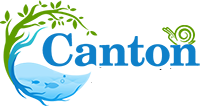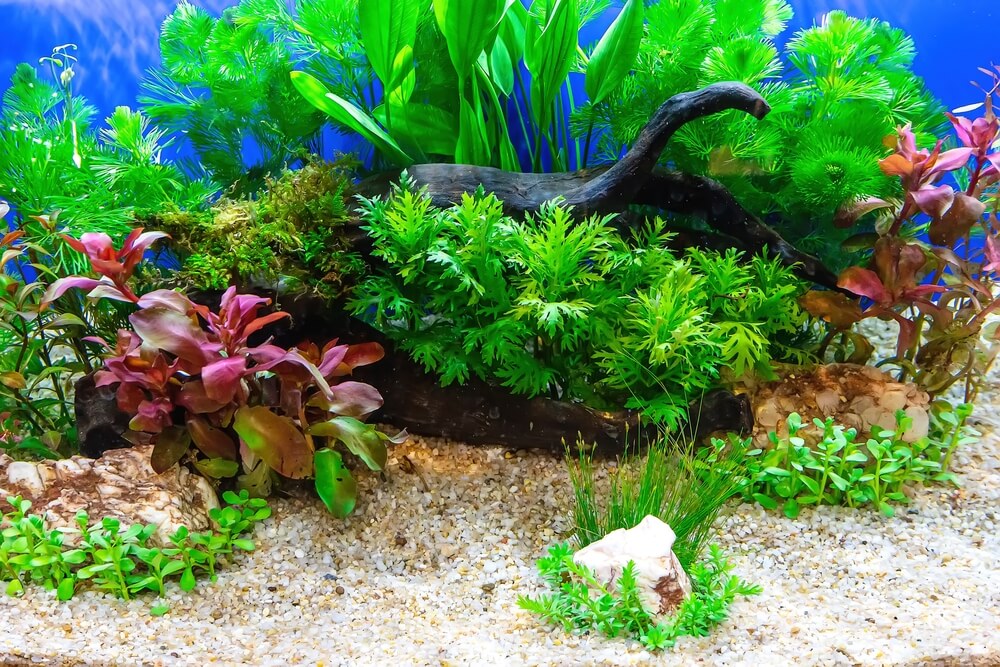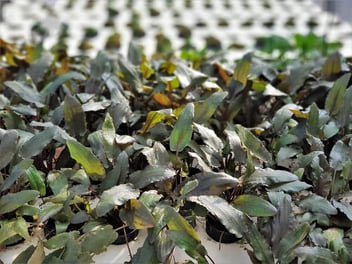From Selection to Care: Mastering the Art of Aquatic Plant Life

Welcome to the world of live aquarium plants, an essential element of any thriving aquarium. These natural wonders do more than just beautify your tank; they create a dynamic ecosystem that benefits both the water and its inhabitants. In this guide, we'll explore the significant role live plants play in aquariums and how they enhance the overall health and aesthetic of your underwater world.
Live aquarium plants offer a multitude of benefits. They help in maintaining water quality by absorbing excess nutrients and providing oxygen, crucial for a balanced habitat. Plants also offer shelter and security for your fish, replicating their natural environment and promoting healthier, less stressed aquatic life. Additionally, they compete with algae for nutrients, helping to keep algae growth in check.
This guide is crafted with care for both beginners who are just starting their journey in the aquarium hobby and experienced hobbyists looking to deepen their understanding and skills. For newcomers, we'll cover the basics, helping you choose the right plants for your aquarium and providing tips on how to care for them. For the more experienced, we'll delve into advanced topics like aquascaping and optimizing plant growth with CO2 systems.
Join us as we embark on this green journey, enhancing your aquarium with the lush, vibrant life of live plants. Whether your goal is to create a tranquil underwater garden or a vibrant, thriving ecosystem, this guide is your companion in nurturing a healthier, more beautiful aquarium.
Section 1: Basics of Live Aquarium Plants
What are Live Aquarium Plants?
Live aquarium plants are much more than just decorations for your aquarium; they're living organisms that play a crucial role in the aquatic ecosystem. These plants perform several vital functions. They act as natural filters, absorbing carbon dioxide and waste products while releasing oxygen, essential for the health of your fish. Live plants also create a more natural environment for your aquatic creatures, providing them with shelter and breeding grounds, and even reducing stress among fish by offering a semblance of their natural habitat. Furthermore, they compete with algae for nutrients, helping to keep your aquarium clean and algae-free.
Types of Aquarium Plants
When it comes to choosing live freshwater aquarium plants, it's essential to understand the different types available and how they fit into the tank's layout. Generally, aquarium plants are categorized based on their placement and growth habits:
-
Foreground Plants: These are low-growing plants that are placed in the front of the tank. They usually stay short and help create a sense of depth in your aquarium. Examples include:
- Anubias Nana: A hardy plant that thrives in low light conditions.
- Dwarf Baby Tears: Ideal for creating a lush green carpet, requiring moderate to high light.
-
Midground Plants: Midground plants are versatile and can be used to fill the middle section of the tank. They add texture and color and can be used to hide equipment. Examples include:
- Java Fern: Easy to care for and doesn't require substrate, making it ideal for beginners.
- Cryptocoryne Wendtii: A robust plant that comes in various colors and adapts well to different conditions.
-
Background Plants: These are fast-growing, taller plants that are placed in the back of the tank. They create a backdrop and can hide unsightly wires or equipment. Examples include:
- Amazon Sword: A popular choice with large leaves, great for creating a dense background.
- Water Wisteria: Known for its fast growth and ability to absorb excess nutrients, reducing algae.
Each type of plant has its unique requirements and benefits, and understanding these will help you create a balanced and aesthetically pleasing aquarium. Remember, the right combination of these plants can transform your aquarium into a vibrant underwater garden.
Section 2: Benefits of Live Aquarium Plants
Enhancing Water Quality
One of the most significant benefits of live aquarium plants is their ability to enhance water quality. These plants act as natural filters in your aquarium ecosystem. They absorb harmful chemicals like ammonia, nitrates, and nitrites, which are byproducts of fish waste and decomposing food. By consuming these substances, live plants help in reducing the toxicity of the water, making it safer and healthier for your aquatic life. Moreover, they release oxygen through photosynthesis, which is crucial for the respiration of fish and beneficial bacteria. This natural process of purification ensures a stable and balanced aquatic environment, reducing the need for frequent water changes and mechanical filtration.
Natural Habitat for Fish
Live plants are not just aesthetic elements; they recreate a natural habitat for your fish. In the wild, fish rely on plants for shelter, safety, and breeding grounds. In an aquarium, plants provide similar benefits. They offer hiding spots for shy or territorial fish, reducing stress and aggression among tank inhabitants. This is especially important in community tanks, where different species coexist. Plants also play a vital role in the breeding process of many fish species, providing safe places for laying eggs or protecting fry (baby fish). By mimicking the natural environment, live plants encourage natural behaviors and contribute to the overall well-being of your fish.
Aesthetic Appeal
Beyond their functional benefits, live aquarium plants are prized for their aesthetic appeal. They add a vibrant, lush element to your aquarium, transforming it into a captivating underwater landscape. With a variety of shapes, sizes, and colors available, these plants allow hobbyists to create unique and beautiful aquascapes. Whether you're aiming for a densely planted jungle look or a minimalist design, live plants offer endless possibilities for personalization. The dynamic nature of growing plants also brings a sense of change and evolution to your aquarium, as they grow and transform the space over time. This visual enhancement not only makes your aquarium more enjoyable to look at but also turns it into a living piece of art.
Section 3: Choosing the Right Plants
Considerations for Plant Selection
Choosing the right plants for your aquarium involves several important considerations. Here are key factors to keep in mind:
-
Lighting Requirements: Different plants have varying light needs. Some thrive in low light, while others require intense lighting. Assess the lighting conditions of your aquarium and choose plants that will thrive under those conditions.
-
Water Conditions: Pay attention to your aquarium's water parameters, such as pH, hardness, and temperature. Some plants prefer acidic conditions, while others need alkaline or harder water.
-
Fish Compatibility: Certain fish species may nibble on or uproot plants. Research the compatibility of your fish with the plants you intend to introduce.
-
Growth Habits: Consider the growth rate and final size of the plants. Ensure that they fit well in your aquarium space without overcrowding.
-
Maintenance Level: Some plants require more care, including regular pruning and specific fertilization. Choose plants that match your willingness and ability to provide care.
Top Plants for Beginners
If you are new to aquarium planting, here are some beginner-friendly plants that are easy to care for and can tolerate a range of conditions:
-
Java Moss: This is a versatile plant that doesn’t require strong lighting and can be attached to various surfaces.
-
Anubias: These are hardy plants that can grow in low light and are less likely to be eaten by fish. They can be attached to rocks or driftwood.
-
Hornwort: A fast-growing plant that can be used as a floating plant or anchored in the substrate. It is great for absorbing excess nutrients in the water.
-
Amazon Sword: A popular choice that can adapt to various water conditions and provides a lush, green backdrop.
-
Marimo Moss Balls: Unique and nearly indestructible, these moss balls are a fun addition and require minimal care.
By starting with these plants, beginners can enjoy the beauty and benefits of live plants in their aquariums with a manageable level of care.
Section 4: Planting and Maintenance
How to Plant Aquarium Plants
Planting aquarium plants properly is essential for their growth and health. Here are the steps:
-
Preparation: Rinse the plants gently in dechlorinated water to remove any debris or pests.
-
Substrate: Choose a nutrient-rich substrate that is suitable for planting. Some plants need to be rooted in the substrate, while others can be attached to decorations.
-
Planting Technique:
- For rooted plants, create a small hole in the substrate and insert the plant's roots before gently covering them with the substrate.
- For plants that attach to surfaces, use thread or fishing line to tie them to rocks or driftwood.
-
Spacing: Ensure plants have enough space between them to allow for growth and adequate light exposure.
-
Water Level: Initially, you can plant in a low water level to make the process easier, then gradually fill the tank.
Maintaining Healthy Plants
Regular maintenance is key to keeping your plants healthy. Here are some maintenance tips:
-
Lighting: Ensure your plants receive the right amount and intensity of light they need.
-
Nutrients: Fertilize your plants regularly. Use a quality aquarium plant fertilizer that provides essential nutrients like nitrogen, phosphorous, potassium, and trace elements.
-
Pruning: Trim plants regularly to prevent overgrowth, which can affect water flow and light distribution in the tank.
-
Monitoring: Keep an eye on your plants for signs of poor health, like discoloration or wilting, and address any issues promptly.
-
Water Quality: Regular water changes are important to maintain nutrient levels and remove excess waste that can harm plants.
-
Algae Control: Keep algae in check as it can compete with your plants for nutrients and light. This can be managed by controlling light exposure and nutrient levels in the water.
Common Issues and Solutions
- Yellowing Leaves: Could indicate a nutrient deficiency. Ensure proper fertilization and check lighting conditions.
- Slow Growth or Pale Leaves: Often a sign of insufficient lighting or CO2. Consider upgrading your lighting system or adding a CO2 system.
- Rotting Roots or Leaves: May occur due to poor substrate conditions or over-fertilization. Ensure the substrate is suitable and avoid over-fertilizing.
Remember, each plant species may have specific needs, so it's important to research the requirements of each plant you have in your aquarium.
Section 5: Troubleshooting Common Issues
Aquariums with live plants can sometimes face challenges. Here's how to identify and address some common issues:
Dealing with Algae
Algae growth is a common challenge in planted aquariums. To manage algae:
- Control Nutrients: Excess nutrients, especially nitrates and phosphates, can lead to algae blooms. Regular water changes and careful feeding can help control nutrient levels.
- Manage Lighting: Too much light can encourage algae growth. Use a timer to regulate light exposure to about 8-10 hours a day.
- Algae Eaters: Consider adding algae-eating fish or invertebrates like Otocinclus catfish, Siamese algae eaters, or Amano shrimps.
- Manual Removal: Regularly remove visible algae from surfaces and plants.
Plant Diseases
Like any living organism, plants can suffer from diseases. Here are some common issues:
- Brown or Black Spots on Leaves: This could be a sign of a fungal infection. Improve water quality and consider using a fungicide recommended for aquariums.
- Hole in Leaves: Often caused by a deficiency in nutrients, especially potassium. Ensure a balanced fertilization.
- Root Rot: Poor substrate drainage or overwatering can lead to root rot. Ensure the substrate is not too compact and avoid over-fertilizing.
Pest Infestations
Pests can occasionally be introduced with new plants. To deal with them:
- Snails: While some are beneficial, overpopulation can be a problem. Control them manually or introduce snail-eating species.
- Aquarium Plant Parasites: Inspect new plants before adding them to your tank. If you spot parasites, quarantine and treat the plants before introducing them to the main tank.
Water Chemistry Imbalances
- pH Fluctuations: Test your water regularly. Drastic changes in pH can stress plants. Adjust your water treatment routine as needed.
- Hardness Issues: Some plants prefer specific water hardness levels. Use water conditioners to adjust the hardness to suit your plants.
Remember, the key to a healthy aquarium is regular monitoring and maintenance. By staying vigilant and addressing issues promptly, you can maintain a thriving aquatic environment for your plants and fish.
Section 6: Advanced Topics
For those looking to take their aquarium hobby to the next level, here are some advanced topics to explore:
Aquascaping with Live Plants
Aquascaping is the art of arranging aquatic plants, rocks, stones, cavework, and driftwood in an aesthetically pleasing manner within an aquarium—in essence, gardening under water. Tips for successful aquascaping include:
- Understand Layout Principles: Learn about different styles like the Nature Style, Dutch Style, and Iwagumi. Each has its unique layout principles and plant choices.
- Focal Points and Depth Creation: Use techniques like the rule of thirds to create engaging and balanced compositions.
- Choosing the Right Plants: Select plants based on their growth habits and colors to create contrast and depth.
- Regular Maintenance: Trim and maintain plants to preserve the desired aesthetic.
CO2 Systems for Plant Growth
Carbon dioxide is essential for plant growth. Advanced hobbyists often use CO2 systems to boost plant growth, especially in densely planted tanks. Considerations include:
- Types of CO2 Systems: Choose between DIY setups or professional CO2 systems.
- Regulation and Monitoring: It's crucial to regulate CO2 levels to avoid harming fish. Use a CO2 checker and a reliable regulator.
- Balancing Light and CO2: Ensure that your lighting is adequate to support the increased photosynthesis that comes with added CO2.
Advanced Fertilization Techniques
In addition to CO2, plants need a range of nutrients. Advanced fertilization methods can be explored:
- Macronutrients and Micronutrients: Understand the balance of essential nutrients like nitrogen, phosphorous, potassium (NPK), iron, and magnesium.
- Liquid vs. Substrate Fertilizers: Some plants feed through their roots while others feed through their leaves. Choose your fertilizers accordingly.
- Dosing Strategies: Explore methods like Estimative Index (EI) or Perpetual Preservation System (PPS) for systematic fertilization.
Lighting for Planted Aquariums
Proper lighting is critical for plant health and growth. Advanced hobbyists might explore:
- Spectrum and Intensity: Different plants require different light spectrums and intensities.
- Photoperiod Management: Managing the duration of light exposure to optimize plant growth and health.
- LED Technology: Advancements in LED lighting offer greater control over light intensity and spectrum.
By delving into these advanced topics, you can further enhance the health and beauty of your aquarium, create stunning aquascapes, and enjoy the rewarding process of cultivating a thriving underwater garden.
Conclusion
As we've explored in this guide, live aquarium plants offer more than just aesthetic value to your aquarium; they are vital components of a healthy aquatic ecosystem. They enhance water quality, provide natural habitats for fish, and contribute to the overall balance of your aquarium's environment. The joy of cultivating these plants goes beyond mere observation; it involves an interactive experience that connects you more deeply with the natural world.
Whether you're a beginner or an experienced hobbyist, the journey of growing live aquarium plants is rewarding and constantly evolving. There's always something new to learn, a different plant to try, or a unique aquascape to create. We encourage you to take the plunge into the world of live aquarium plants. Start small, experiment, and watch your underwater garden flourish.
FAQs About Live Aquarium Plants
Q: How often should I fertilize my aquarium plants? A: It depends on the type of plants and your tank's specific needs. Generally, a weekly fertilization schedule is a good start, but adjust based on plant response and growth.
Q: Can I keep live plants in a tank with fish? A: Absolutely! In fact, live plants can benefit fish by improving water quality and providing shelter. Just make sure the plants and fish are compatible.
Q: Do I need a special substrate for my plants? A: While some plants can grow in regular gravel, many benefit from a nutrient-rich substrate designed for planted aquariums.
Q: How much light do my aquarium plants need? A: Light requirements vary depending on the plant species. Typically, 8-10 hours of light per day is a good range, but adjust according to your plants' needs.
Q: Can live plants help control algae? A: Yes, live plants compete with algae for nutrients and light, often helping to reduce algae growth in your aquarium.





Leave a Comment